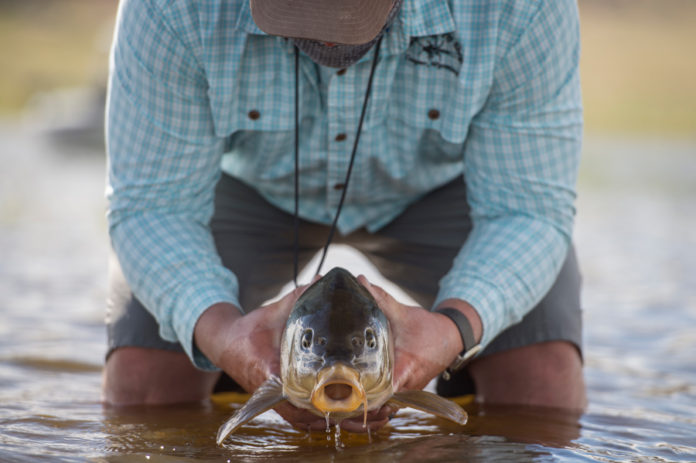Written by: CiCi Oliver, Ugly Bug Fly Shop
Photo courtesy Ugly Bug Fly Shop
Late-summer means lower water levels and higher temperatures here in central Wyoming, so we like to give the trout a break and focus on a less-appreciated and less-fragile quarry: the common carp. We take Rocky Mountain flats-fishing pretty seriously, running full-day skiff trips on Pathfinder reservoir all season long. While fly-fishing for carp can be frustrating even for experienced anglers, improving your fly selection and presentation techniques can greatly increase your chances for success. Below are five of our favorite carp fly patterns, along with some general tips on gearing up. In the next chapter, I discuss some specific strategies for using these flies more effectively.
1. Carp Crack (black, size 6)

The tried-and-true Carp Crack is designed for flats-fishing the Great Plains, but it works here just as well. It’s not too heavy and has a simple profile that is suggestive of many different prey species.
2. Carp Craw (olive, size 8)

The Carp Craw is one of my favorite crayfish patterns for any location in the West. Use short, quick strips to imitate a fleeing crayfish.
3. Wabbit Worm (black, size 8)

Catch’s Wabbit Worm can be an irresistible carp pattern when stripped slowly, leaving a mud trail across the bottom.
4. Fat Albert (brown, size 10)

The Fat Albert was designed to imitate almost any terrestrial bug. This pattern is incredibly productive when fished alone, or with an added dropper, such as a Hope Damsel nymph.
5. Turk’s Tarantula (tan, size 8)

The Turk’s Tarantula dry fly is a pure attractor pattern, loosely imitating either a terrestrial or an adult stonefly. The exaggerated wing, long rubber legs, and enlarged head create a tempting target.
A 7- or 8-weight rod rigged with floating line is best. Try using a 10-foot, all-fluorocarbon leader tapering down to 12-pound tippet. The extra stiffness helps when delivering longer casts, and fluoro also sinks quicker. We typically attach flies with loop knots in order to allow them to move more freely.
CiCi Oliver works for Ugly Bug Fly Shop in Casper, Wyoming
Credit: Source link































